
Bulletin 8 (IV:2), 1966
Home
Français
Introduction
History
Annual Index
Author &
Subject
Credits
Contact
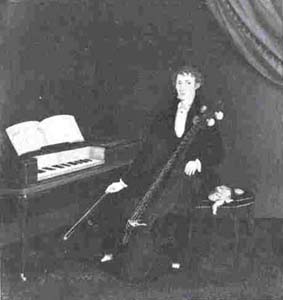
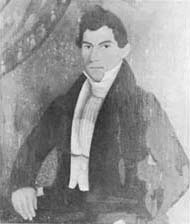
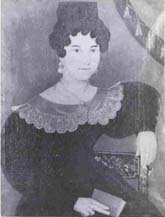
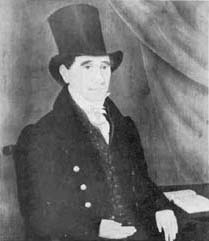
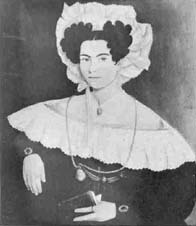
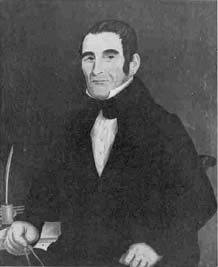
'Drawn by I. Bradley
From Great Britton'
by Mary Childs Black, Director
Museum of Early American Folk Art, New York
and Stuart P. Feld, Associate
Curator
of American Paintings and Sculpture
The Metropolitan Museum of Art, New York
Résumé en français
Pages 1 | 2 |
3 | 4
The first article on the nineteenth-century American folk painter John
Bradley, written by Jean Lipman, appeared in Art in America more
than twenty years ago. On the basis off our signed portraits, dating from
1832 to 1845, forty-five other paintings, all portraits, were attributed
to him. Now, after years of additional study, none of these attributions
can be accepted. Twenty-nine of the subjects, residents of Connecticut
and New York State, are now attributed on the basis of firm stylistic and
genealogical evidence to Ammi Phillips, an artist who has himself only
recently emerged from the anonymity of the Border Limner and the Kent Limner (see Antiques,
December 1961). (1) Three of the original number are assigned to Erastus
Salisbury Field on like grounds, (2) while the remaining portraits appear
to be by three or more artists who have yet to be identified.
The four signed portraits by Bradley are unquestionably close
to some of the paintings at present attributed to Phillips, but because
the article dealt so largely with works by other hands, it established
a broad stylistic base that allowed for attribution to Bradley of such
pictures as Boy Holding Dog and Girl with Flower Basket, both
in the collection of the Abby Aldrich Rockefeller Folk Art Collection at
Williamsburg. As a result of the confusion of the work of Phillips and
Bradley, the early study of Bradley forwarded conclusions about his activity
in western Connecticut and New York State. Interestingly, these conclusions
stood in direct contrast to those that could have been drawn from the few
documented facts that were available. Listings in the New York City directories
for the period 1836 through 1847 establish John Bradley as a 'portrait
and miniature painter' at three different locations: first at 56 Hammersley
Street, in 1836-37, next at 128 Spring Street, in 1837-44, and, finally,
at 134 Spring Street, in 1844-47, all ad dresses in the general area of
present-day Houston Street. Further, a pair of dated portraits of Mr
and Mrs Simon Content, who lived on neighbouring Grand Street, pushed his
activity in the city back to 1833.
Since the Lipman article little more has been learned concerning
Bradley himself, aside from a few evocative notices that seem to relate to
him and the conclusions that can be drawn from the 18 additional portraits
by him that have come to light. All of these are signed, and all are dated
or bear ad dresses that establish their dates within a fixed span of years.
While Bradley does not appear in the New York directories until
1836,
a dozen portraits by him date between 1832 and 1834. The subject of only
one, The Cellist, (Fig. 1) in the Phillips Collection, Washington,
D.C., has not been identified. Of the rest, the Contents lived in Manhattan,
and the remaining nine were residents of Staten Island, suggesting that
Bradley himself may have lived there, or may have spent considerable time
there. A search of Staten Island church, genealogical, and historical records
reveals the presence of only one John Bradley there between 1830 and 1850,
but that listing is worthy of some note. A little more than three weeks
before the date of June 19 inscribed on one of Bradley's five portraits
of members of the Totten family of Staten Island, the scribe of the Moravian
Church recorded that John Bradley from Sailors' Snug Harbor - a sailors'
home established by the will of Richard Randall in 1801 'for aged, decrepit
and worn out Sailors' - became 'Deranged 27 May 1834: Since John Bradley
the painter had been associated with Staten Island as early as May 1833,
the date of his first known portraits of Staten Islanders, it may be that
mad John Bradley, who finally died in 1838, was an older relative. It was
probably during his visits to the Island to see his namesake that John
Bradley the portrait painter received the various commissions that have
inextricably associated him with the Island.
Bradley's earliest painting, which is also his most widely known
work, is The Cellist, which is signed and dated '1. Bradley Deli"
1832: Although it is considerably smaller in size than any of Bradley's
other works. it is his only full-length portrait of an adult. The subject,
whose name and home are unknown, holds a cello as he sits on a bench before
a pianoforte, on which is a book of music opened to a piece called MILDRED
COURT. P. M. A pitch pipe and figured silk scarf lie at his side. The
picture is a fully realized likeness, quickly painted but beautifully composed.
It is a portrait d'apparat in the eighteenth-century sense, with
Bradley depicting his subject along with objects that are obviously meant
to reveal his interests and preoccupations. Unquestionably, Bradley was
as careful to capture a good likeness of his sitter as he was to show the
carpet, the piano, the bench, and the other objects with which he surrounded
the musician.
The unique style that Bradley used in the short decade
and a half that encompasses all his known works is visible in his earliest:
the portrait has a hard, sharp, liney quality, in which silhouette is used
to great advantage. In contrast to other self-taught painters of the
period, who often used heavy dark lines to outline their forms, Bradley
outlined heads, hands and other elements with a line of white paint that
gave an unusual sense of depth and volume to his rather flat forms. His favourite
scheme of colour is already apparent in the brilliant dark-green figured
carpet, the rich red drapery with gold tassels, and the medium-brown background.
The first of Bradley's Staten Island sitters were Captain John
Cole {Fig. 2) and his wife Catherine Rachel Winant Cole {Fig. 3), whose
portraits Bradley dated 1 May 1833, when Cole was 26 and his wife 19. The
Coles had been married in December 1831 in Woodrow Methodist Church, Staten
Island; Cole was described as a' "waterman" of Westfield', a community
on Staten Island. Both portraits have been badly damaged and extensively
repainted, especially in the heads, but details of Bradley's crystalline
style remain in the hands and in the costumes. Bradley's colours are repeated
in the red drapery {again with gold tassels), in the red book in Mrs Cole's
hand, and in the green baize table cover upon which Cole rests his hand
on a brown leather book with the title History of the United States.
Next Page | Bradley
in New York
1 | 2 |
3 | 4
Annual Index | Author & Subject | Credits | Contact
This digital collection
was produced under contract to Canada's Digital Collections program,
Industry Canada.
"Digital
Collections Program, Copyright
© National Gallery of
Canada 2001"